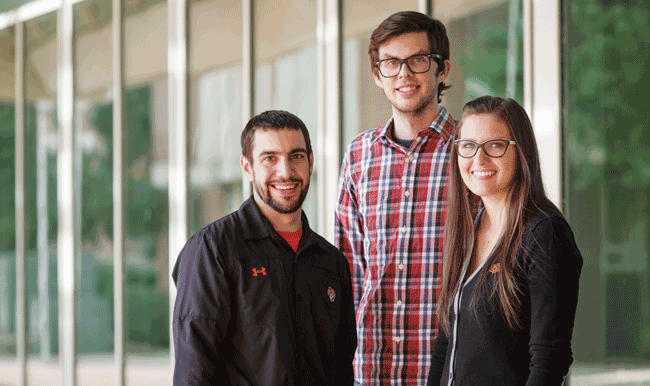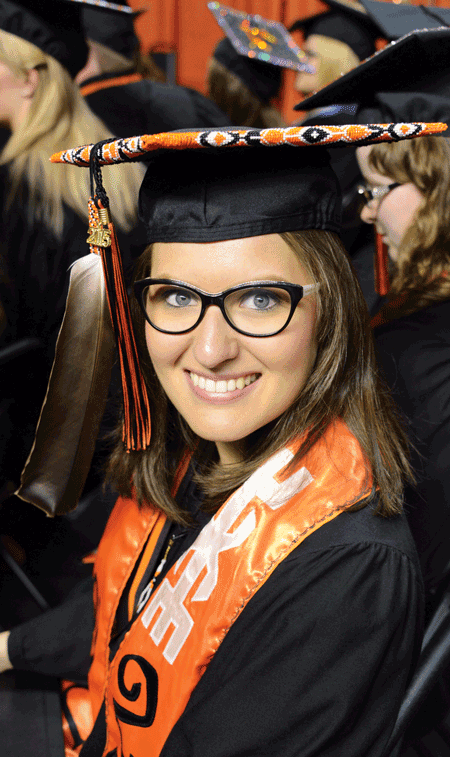Blending Cherokee Beliefs with Passion for Science
Wednesday, January 13, 2016

Amber Suena Anderson’s full name means “golden beyond tomorrow,” and the Cherokee Nation citizentakes this meaning to heart.
“I’ve always felt like with my name, I have a responsibility to take care of those in the generations to come,” Anderson says.
It is a philosophy she refined and solidified during her years as a biochemistry and molecular biology student at Oklahoma State University.
The recent alumna from Warr Acres, Oklahoma, says two things affected her the most as a student at OSU – undergraduate research and involvement with Native American communities. And combining the two has transformed her into the individual she is today, she says.
Anderson is thankful to have found a unique way to weave her culture into her passion for science.
It is a traditional Cherokee belief to keep seven generations, both ahead of you and behind you, in mind for everything you do. She says this belief encouraged her to serve as a mentor for other Native American students at OSU through various roles such as Miss American Indian OSU and Native American Student Association president.
Her platform as the 2012-2013 Miss American Indian OSU was to challenge more Native American students to become involved in research.
“I try to encourage Native American students, especially in the science, technology, engineering and mathematics fields, to know not only what their potential is, but also the importance of them becoming involved in research and extracurricular activities that will allow them to achieve things they never imaged they could before,” Anderson says.
Her interest in Native American health was sparked as a child by her dad’s work in the public health field. Her passion for research did not fully develop until she arrived at OSU, she says. As a Freshman Research Scholar, she was in Patricia Canaan’s research lab — and after her first semester, she was hooked.

Canaan, an associate professor of biochemistry and molecular biology, calls Anderson’s enthusiasm contagious.
“Amber is an excellent role model and ambassador for Native Americans and she has always represented the OSU Department of Biochemistry and Molecular Biology well throughout her multiple events and occasions,” Canaan says. “We are excited to see how she succeeds in her future pursuits in public health.”
Anderson has experienced Harvard Medical School in Boston and Brookhaven National Laboratory in New York thanks to internships and summer research programs.
But an experience closer to home at the Oklahoma City Area Inter-Tribal Health Board confirmed her career path.
“In this position, I was treated as a young professional in the field as opposed to an intern,” Anderson says. “I had the opportunity to help create a prescription drug abuse fact sheet that was distributed throughout the state, so in a sense, I felt like I was making an impact to many tribal communities and generations.”
During this internship, Anderson became involved in a research project about perceptions of Native Americans.
The study, sponsored by the Oklahoma Area Tribal Epidemiology Center and AARP, included a tribal community survey to better understand the beliefs of American Indians/Alaska Natives living in Oklahoma. Anderson says the assessment provided information on the challenges and priorities in life, monthly expenses and consumer-related issues.
“This research is unique because, although there has been a lot of Native American research in the past, there has hardly ever been a focus on the perceptions of Native Americans,” Anderson says. “Stepping into the community and being submerged in the culture opened up great opportunities for gathering usable information.”
Anderson presented this research at the Society for the Advancement of Chicanos and Native Americans in Science National Conference in Los Angeles last year.
SACNAS was founded more than 40 years ago by career academics and research scientists committed to unifying their voice and offering guidance to Hispanics, Chicanos and Native Americans in the STEM fields.
The national conference is a gathering of nearly 4,000 students and professionals, and includes more than 1,000 poster presentations.

Anderson has qualified to attend the conference since 2012. Her final conference as an OSU student will be the most memorable because she received an outstanding poster presentation award.
“This award is the highlight of my research career because I have poured so much of my heart into my research,” Anderson says. “It was very rewarding to earn an award the last year I was able to go and to represent my university and academic college on a national platform.”
She feels sharing her love for the topic felt like more of a conversation with the judges and participants instead of a formal poster presentation.
“If you’re passionate about something, it is very easy and fun to talk about it,” Anderson says. “You long to share your knowledge with others.”
Anderson says being a biochemistry and molecular biology student was often challenging, but she is thankful she stuck it out.
“There were times when it was tempting to give up,” she says. “The faculty in my department have all helped me and encouraged me on. I’m really glad I never gave up on my dreams.”
John Gustafson, biochemistry and molecular biology department head, said having diverse leaders will be essential for the next generation of students, and he is confident Anderson will fulfill this responsibility.
“The diversity in science including women is very scarce, and we must work toward decreasing this lack,” he says. “How can we continue enhancing additional students that represent diversity if we do not have these people as role models? This is what makes Amber so unique. She is that role model.”
Because of her academic success and involvement at OSU, Anderson also was named the first recipient of the Cherokee Nation Foundation OSU Scholarship.
To symbolize her time at OSU, Anderson ordered her graduation cap and gown months in advance so she and her mom, Tina, would have time to bead her cap. The two have always enjoyed beading and making jewelry together, and this project may be the most unforgettable for both of them.
She says the beading was done on a loom, using orange and black colors they selected together.
An eagle feather varies in meaning from person to person. For Anderson, it was symbolic of hard work, dedication and commitment to her people. As she earns future degrees, she says the collection of feathers will represent each of her experiences and collectively represent her journey to serve the Native American population.
During her commencement ceremony in May 2015, Anderson says she was flooded with emotion looking up at the beaded feather hanging next to her tassel.
“I was thinking about how fortunate I am to have graduated from a university that is supportive of all displays of cultures as well as the many memories I have made here,” Anderson says.
As she walked across the stage of Gallagher-Iba Arena to receive her diploma, she says even President Burns Hargis complimented her on her beaded feather.
Anderson is pursuing a master’s degree in public health with an option in American Indian public health at North Dakota State University.
She chose NDSU for graduate school because it is the only public health school in the nation with this study option. She says she is extremely excited for her courses, such as research issues in tribal communities and American Indian health disparities, because she feels they were custom designed for her interests.
“As soon as I received notification of my acceptance, I suddenly felt so at peace with everything in my life because I knew now that this is the direction I was destined to go,” Anderson says.
In the future, she hopes to continue her educational journey to earn a doctorate while continuing to study infectious diseases.
“With these degrees, I will work to improve the health of the Cherokee Nation and other tribal members by focusing on disease prevention and educational programs,” Anderson says. “Someday I hope to have my own research lab focusing on just that.”
Story by Jacy Bradford
